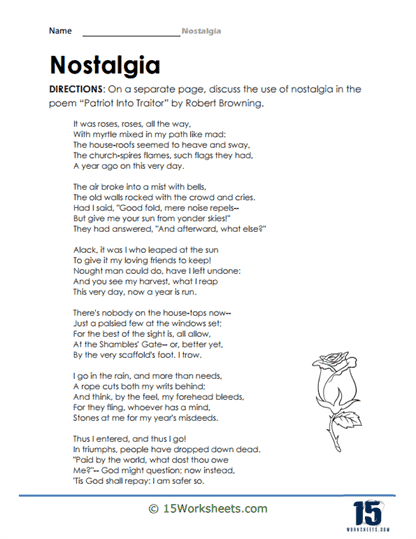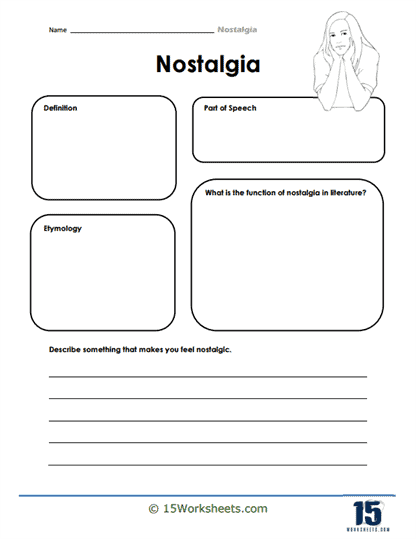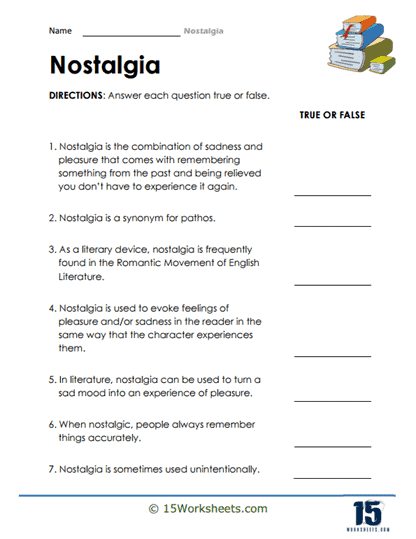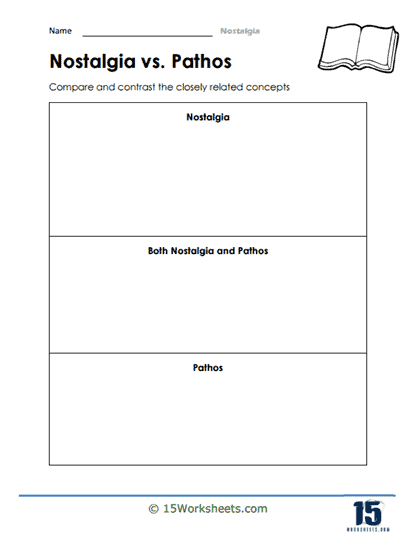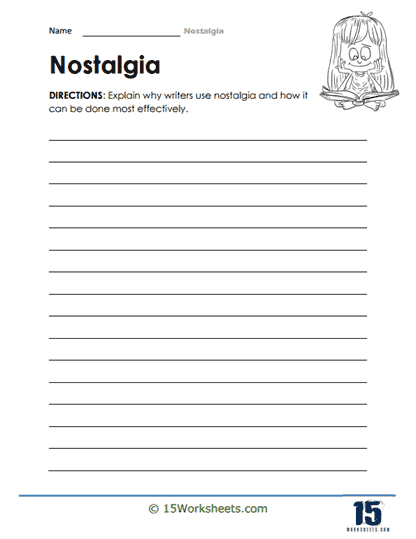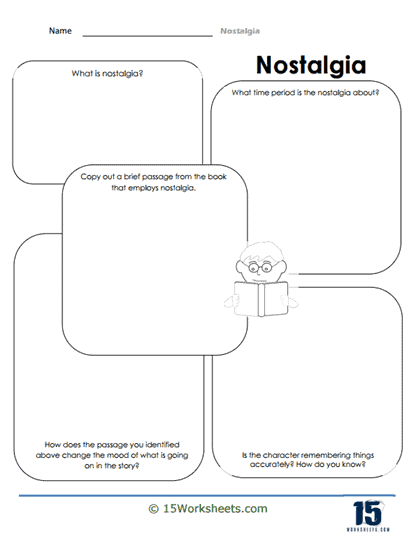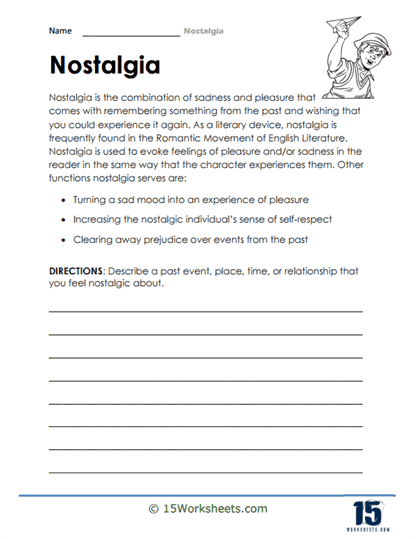Nostalgia Worksheets
About These 15 Worksheets
These worksheets engage students’ memories and emotions, connecting them to various language arts and reading concepts. These worksheets tap into the psychological phenomenon of nostalgia, the sentimentality for the past, typically for a period or place with happy personal associations. By leveraging this emotional connection, Nostalgia Worksheets aim to enhance learning experiences, making them more memorable and impactful for students. These exercises come in various forms, each targeting different aspects of language arts and reading skills, from vocabulary development to comprehension and critical thinking.
Through a variety of exercises, these worksheets help students improve their vocabulary, comprehension, writing skills, and critical thinking. By connecting learning to personal memories and emotions, Nostalgia Worksheets make language arts and reading skills more engaging, memorable, and impactful. This innovative approach not only fosters academic skills but also encourages emotional intelligence and empathy, making it a valuable addition to any language arts curriculum.
Types of Exercises
Memory Lane Vocabulary Building – These exercises prompt students to recall past events, items, or periods and describe them using new vocabulary words. For instance, students might be asked to describe a childhood toy using a list of adjectives they’ve recently learned. This practice not only helps in consolidating new vocabulary but also in making the words more relatable and memorable.
Historical Context Reading Comprehension – Students are given passages related to specific historical periods or events they might feel nostalgic about, even if they did not experience them directly. These could be excerpts from classic novels, historical speeches, or descriptive passages about past decades. Questions following the passages test comprehension, inferencing, and critical thinking, encouraging students to connect emotionally with the material while understanding its context.
Personal Narrative Writing – Here, students write personal narratives or essays about experiences from their past, focusing on a nostalgic memory. This exercise helps students practice narrative structure, descriptive writing, and reflection. It encourages them to explore their emotions and memories, translating them into coherent, engaging stories.
Thematic Analysis of Nostalgic Literature – Students analyze themes of nostalgia in literature, identifying how authors convey longing for the past or depict historical settings. This exercise improves analytical skills, with students examining character motivations, settings, and plot developments in the context of nostalgia.
Comparative Literature Studies – These exercises involve comparing contemporary texts with those from a previous era, focusing on how different periods view nostalgia. Students discuss how nostalgia’s portrayal reflects the culture and values of the time, enhancing their understanding of literary periods and movements.
Creative Writing Prompts – Inspired by nostalgic themes, students create short stories, poems, or dialogues that evoke a sense of nostalgia. This fosters creativity and allows students to experiment with evoking emotions through their writing, practicing tone, mood, and stylistic choices.
Nostalgia in Media and Film Studies – Students analyze how nostalgia is used in media and films, discussing its impact on viewers’ perceptions and emotions. This helps students understand narrative techniques, visual storytelling, and the role of context in evoking nostalgia.
The Benefits of These Worksheets
1. Enhancing Vocabulary Retention – By connecting new vocabulary to personal memories or historical contexts that evoke nostalgia, students are more likely to remember and understand these words. The emotional connection acts as a mnemonic device, making learning more effective.
2. Improving Comprehension and Critical Thinking – The use of nostalgic content in reading comprehension exercises encourages students to engage more deeply with the material. This deep engagement improves their ability to infer meaning, analyze texts, and think critically about what they read.
3. Encouraging Personal Connection to Literature – By analyzing themes of nostalgia in literature, students develop a personal connection to the texts. This fosters a deeper understanding of literary devices, themes, and character development, as students relate their feelings and experiences to those depicted in the literature.
4. Developing Writing Skills – Writing exercises that focus on personal memories or nostalgic themes help students practice narrative structure, descriptive writing, and emotional expression. This not only enhances their writing skills but also encourages self-reflection and personal expression.
5. Fostering Creativity and Imagination – Creative writing prompts inspired by nostalgia push students to use their imagination, explore different narrative voices, and experiment with stylistic choices. This creativity in writing encourages students to think outside the box and develop their unique writing style.
6. Enhancing Engagement and Motivation – The emotional resonance of nostalgia makes learning more engaging and memorable. When students are emotionally invested in their learning materials, they are more motivated to participate and put effort into their work, leading to better learning outcomes.
7. Building Empathy and Cultural Understanding – Exercises that explore nostalgia across different times and cultures help students develop empathy. They learn to understand and appreciate diverse perspectives and experiences, which is crucial for reading comprehension and critical analysis of literature.
What is the Literary Device of Nostalgia?
The literary device of nostalgia is a powerful tool used by authors to evoke a sentimental longing or wistful affection for the past among readers. This technique taps into the universal human experience of reminiscing about past moments, people, or settings that were meaningful or significant. Nostalgia in literature serves not just as a way to paint vivid pictures of the past but also as a mechanism to explore themes of time, memory, loss, and the contrast between the past and present. Its usage enriches narratives, providing depth and emotional resonance that can profoundly impact the reader’s experience.
The Defining Feature of Nostalgia
The main defining feature of nostalgia is its ability to transport readers back in time, invoking memories and emotions associated with past experiences, albeit indirectly through characters, settings, or narratives. Nostalgia leverages the reader’s own sentimental feelings or evokes a longing for a time or place they have never experienced, imbuing the story with a sense of universality and timelessness.
Characteristics of Nostalgia
Sentimentality for the Past – Nostalgia is characterized by a deep sentimentality, often idealizing past times as better, simpler, or more meaningful than the present.
Evocation of Personal Memories – It frequently triggers personal memories in readers, connecting the literary work to their own experiences.
Bittersweet Emotion – Nostalgia carries a bittersweet tone, combining the happiness of reminiscing with a sadness for what is lost or cannot be reclaimed.
Reflection on Change and Time – It reflects on change, emphasizing the passage of time and often the loss of innocence, simplicity, or joy.
Universal Appeal – Nostalgia has a universal appeal, touching on emotions and experiences common to the human condition.
Use of Detailed Descriptions – Authors often employ detailed, sensory descriptions to vividly recreate the past, making it palpable to the reader.
Examples of Nostalgia in Literature
“The Great Gatsby” by F. Scott Fitzgerald – This novel prominently features nostalgia through the character of Jay Gatsby, who is driven by his longing for the past he shared with Daisy Buchanan. Gatsby’s lavish parties and extravagant lifestyle are all part of his attempt to recreate and relive a bygone era. Fitzgerald uses Gatsby’s nostalgia not just to develop his character but also to critique the American Dream and the notion that one can recapture the past through wealth and determination.
“Remembrance of Things Past” (or “In Search of Lost Time”) by Marcel Proust – Proust’s magnum opus is fundamentally built around the concept of nostalgia, most famously exemplified through the “madeleine episode” where the taste of a madeleine cake dipped in tea evokes a powerful involuntary memory of the narrator’s childhood. The novel explores how sensory experiences can trigger deep memories and reflects on the nature of time, memory, and the past’s inescapable influence on the present.
“To Kill a Mockingbird” by Harper Lee – Lee’s novel is narrated from the perspective of Scout Finch, who looks back on her childhood in the racially segregated American South. The nostalgic lens through which Scout recalls her experiences allows the reader to perceive the innocence of childhood juxtaposed against the harsh realities of adult prejudices and injustices. This contrast enhances the novel’s themes of racial injustice, moral growth, and the loss of innocence.
The Effect of Nostalgia on the Reader
The use of nostalgia in literature has a profound effect on readers, engaging them emotionally and intellectually in several ways:
Emotional Engagement – Nostalgia evokes a strong emotional response, making readers more invested in the narrative and characters. It can make the story more relatable and impactful, as readers connect their own memories and feelings to those presented in the text.
Enhanced Imagery and Atmosphere – Through detailed descriptions and evocations of the past, nostalgia enriches the story’s imagery and atmosphere, making the settings and contexts more vivid and immersive.
Reflection on Personal and Collective Past – Nostalgia encourages readers to reflect on their personal pasts as well as on historical or cultural periods. This reflection can lead to a deeper understanding of oneself and a broader perspective on societal changes and the nature of memory.
Complex Emotional Experience – The bittersweet nature of nostalgia-mixing joy with sadness-provides a complex emotional experience, enriching the reader’s engagement with the text. It highlights the impermanence of moments and the inevitable passage of time, adding layers of meaning to the narrative.
Sense of Universality – By tapping into a universal human experience, nostalgia helps bridge the gap between the reader and the text, between different cultures or historical periods, fostering a sense of connection and empathy.
Authors use nostalgia not only to give their stories depth and emotional complexity but also to explore themes related to memory, time, and the human condition. Through nostalgia, literature becomes a mirror reflecting the universal experience of longing for the past, offering insights into both the joys and sorrows that come with reminiscing.




